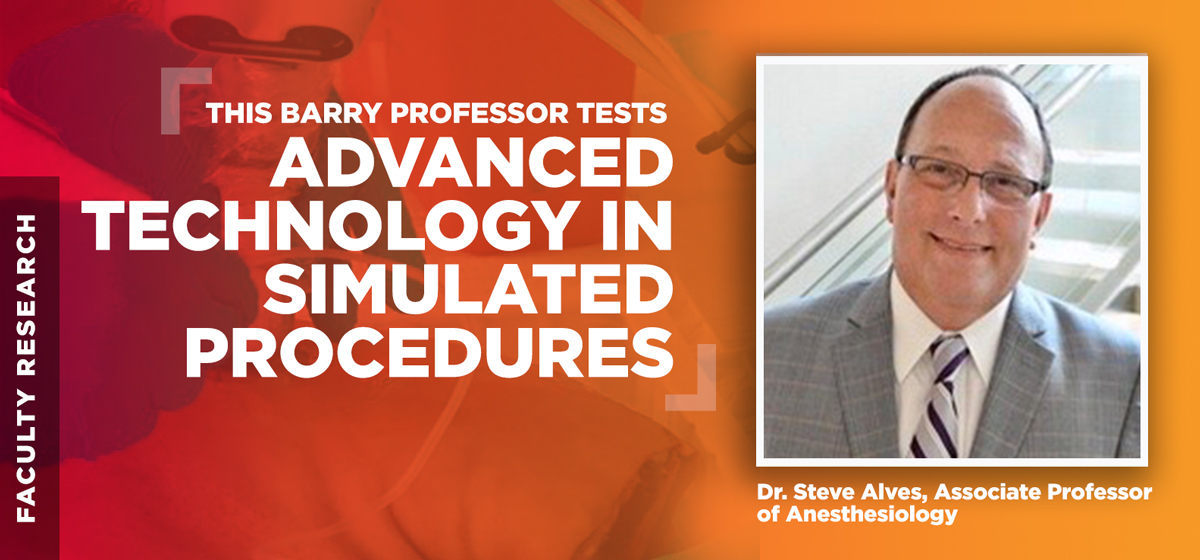When it comes to administering regional anesthetics to mitigate patient pain, the evidence has long been clear: using ultrasound technology to guide injections is both safer and more efficient than blind methods. Now, a promising new technology aims to further improve the performance of ultrasound-guided procedures, and a Barry University professor has found that it may be helpful in training the next generation of student registered nurse anesthetists (SRNAs).
As an educator and clinical practitioner, Associate Professor of Anesthesiology Steve Alves , PhD, CRNA, APRN, FNAP, FAAN, has dedicated much of his career to advancing nurse anesthesia training. Before joining the Barry faculty, he founded the Nurse Anesthesia program at the University of Miami, served as director of the Nurse Anesthesia program at Northeastern University, and oversaw the US Army Graduate Program in Anesthesia Nursing (USAGPAN). At Barry, he, along with colleagues from the University of Miami School of Nursing and Health Studies continue to enhance anesthesia education, most recently by studying the potential benefits of introducing computer-assisted instrument guidance (CAIG) technology to SRNAs early in their training. This latest research endeavor, titled “Use of Computer-Assisted Instrument Guidance Technology by Student Registered Nurse Anesthetists for Simulated Invasive Procedures,” was published in the August 2020 issue of AANA Journal.
Of primary interest to Alves and his co-authors was an FDA-approved Clear Guide Medical device that improves navigation by overlaying a projected needle pathway onto a live ultrasound image. Alves and his colleagues were encouraged by the device trials, which reported that novice nurse anesthetists felt more confident administering ultrasound-guided regional anesthetics with the aid of Clear Guide Medical’s CAIG technology. They theorized that the device could produce stronger outcomes for SRNAs who were just beginning to learn invasive regional anesthesia procedures in simulated environments.
To test this theory, Alves and his colleagues evaluated a group of 26 SRNAs enrolled in their second year of their graduate program. These SRNAs worked in a simulated environment using a store-bought pork shoulder on which they trained and performed transversus abdominal plane (TAP) block procedures. Ultrasound-guided TAP blocks are used for a wide variety of abdominal surgeries, including bowel resections and cesarean sections, and require precise needle insertion. Over the course of their training, the participating SRNAs performed the TAP block procedure using the traditional ultrasound-guided method and the CAIG-supported ultrasound-guided method. To protect the integrity of the study, the students were divided into two groups, with one performing the ultrasound-only method first and the other attempting the CAIG-aided method first. Students in both groups reported that the Clear Guide Medical CAIG device enhanced their confidence and performance, with 96% citing successful CAIG-aided TAP blocks. Additionally, participating SRNAs said the overall procedures ran more smoothly when using the CAIG device and required fewer attempts to complete. Evaluation by their faculty mentors supported the students’ conclusions.
The Nurse Anesthesia curriculum within Barry’s College of Nursing and Health Sciences emphasizes high-tech simulated learning, and Alves’s study highlights the program’s ongoing effort to investigate and employ state-of-the-art training equipment. Based on the promising results determined by Alves and his colleagues, CAIG technology has the potential to advance the education and training of SRNAs and help produce more confident and competent nurse anesthetists.

